The previous seven posts document the days in my journey to Japan in January 2024. This post is a round up of my thoughts and observations around the trip, the photography, the people, the country and everything else that might help out someone else going to Japan. Links to the seven days can be found at the bottom of the post.
The Journey to Japan
When I tell people about my journey to Japan one of the first questions is “How long was the flight?” well it was about 15 hours in total and on the way out there it was difficult to cope with the time stretching out before me. I had trouble sleeping on the plane and didn’t watch much entertainment as I was trying to get to sleep. The Air France flights were ok and comfortable enough with the only real issue being the loss of my suitcase for a day and a half.
Flying from Birmingham into Paris and then onto Haneda was ok too, apart from the rules about taking drinks through customs. I felt like I got ripped off a bit by buying three bottles of Coke in the Duty Free area of Brum airport and hadn’t been outside any secure area so I didn’t see the point of having to throw them away at the security check in Paris, before I got on the plane to Tokyo, Haneda Airport.
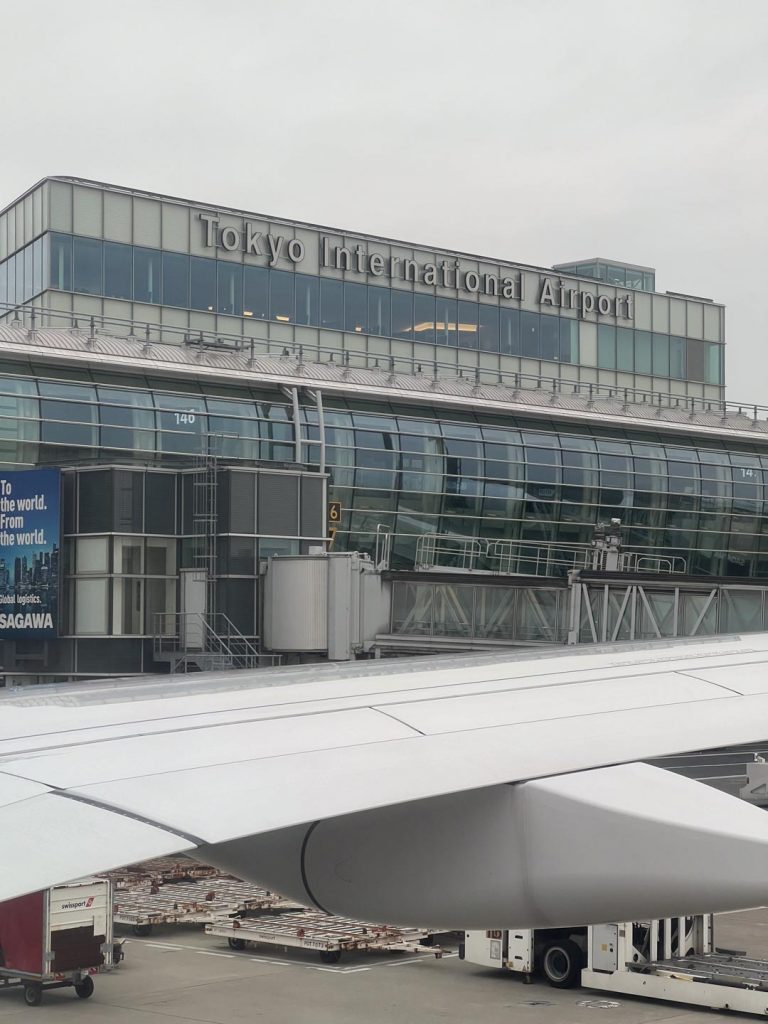
The journey from the airport to the hotel was also easy. Before I left I did a lot of research into the best way of transferring between Haneda and Shinjuku and was looking at the options of taxi, bus, coach, monorail or train. The taxi option was considered to be one of the most expensive ways to get to the hotel and seeing as though I was going to buy a JR Pass for my trip to Hiroshima I knew that this would allow me to catch the monorail as far as Hamamatsucho without any significant costs. This is what I did and it worked out a treat.
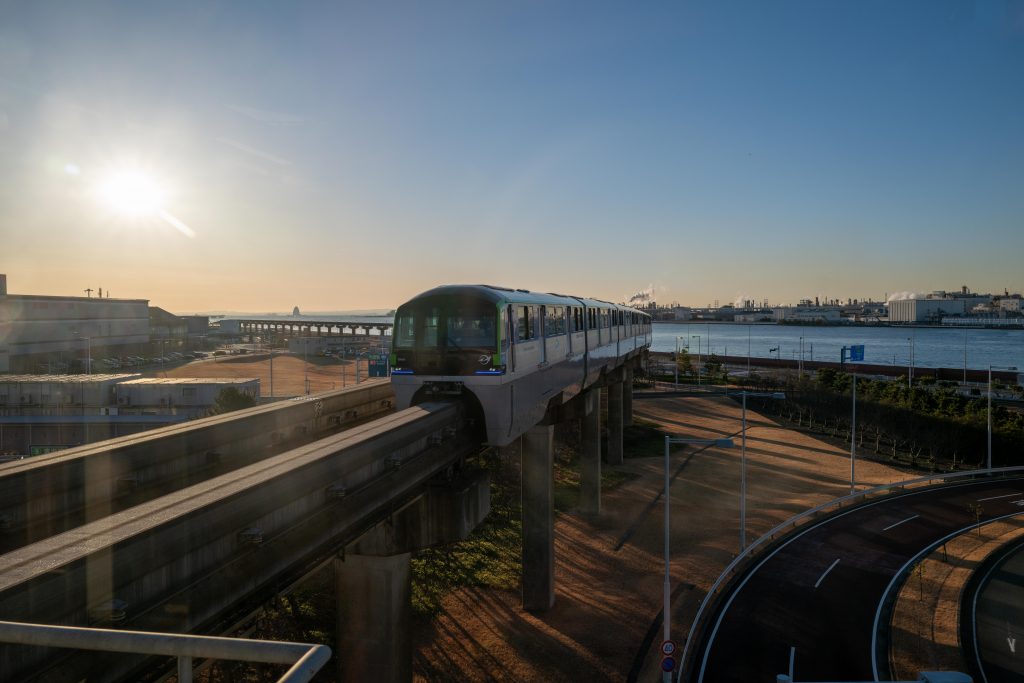
The People
Japanese people are super polite, right? Well yes, most of the people that I met and dealt with were. I was travelling solo completely on my own and didn’t speak to many people at all whilst I was in the country. It’s not that I was avoiding people but I didn’t need to interact with many locals. The first Japanese people I talked to were the airport staff dealing with me when the bag was left behind in Paris, she was helpful and polite with great English language skills and we got the forms completed with no real issues.
After that I spoke with the people at the JR East counter and Ninja WiFi desk, briefly to carry out the transaction but I never spent any real time discussing anything. My Japanese skills are very poor and I know that I’m ignorant for not learning the language but I don’t automatically expect everyone to speak English. If I can work with people to help us achieve the goals then I’m happy, if it means I have to try and use some crap Japanese skills then I’ll give it a go.
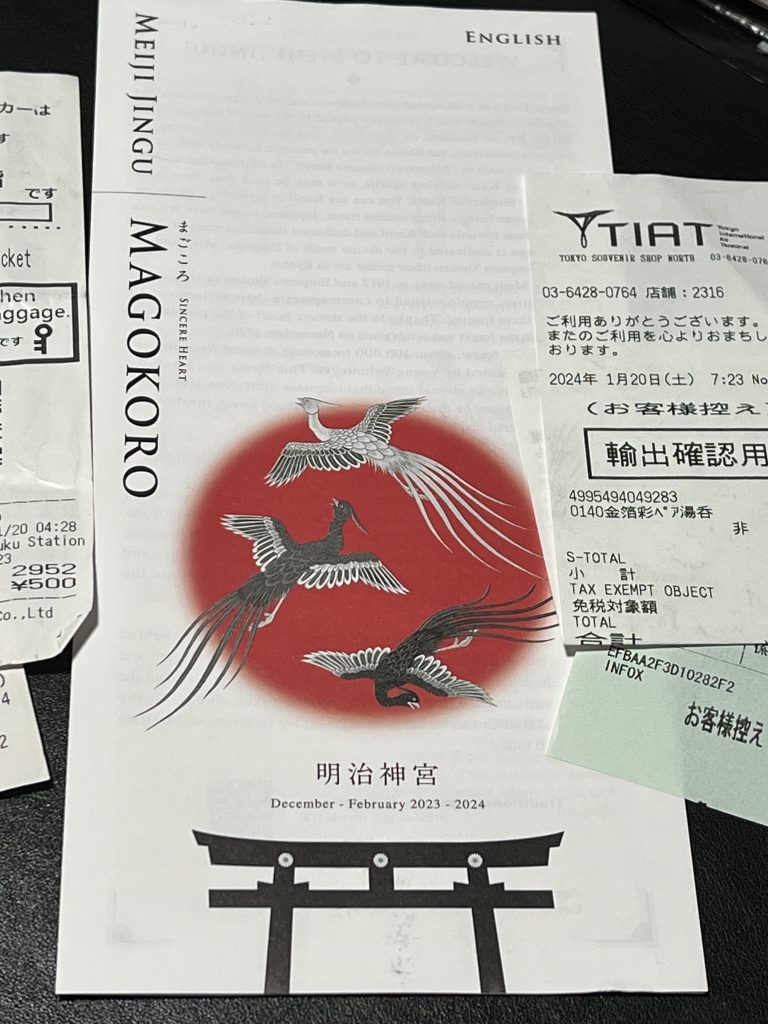
After leaving the airport and riding the monorail to the point where I change to the JR Yamanote line I never spoke to anyone else until I got to Akihabara. I bought a banana and a bottle of coke in a 7-Eleven shop and tried to say “Arigato Gozaimasu” to the store clerk, but I stumbled through and said something like “Arigato Gazamisu” making the clerk laugh to themselves.
The next person I talked with was the hotel check in staff who spoke perfect English and helped me check in to my room. After that I only spoke to the hotel staff once more, when they rang me to go and pick up my suitcase from reception after Air France delivered it to the hotel.
Pretty much all week then the only times I spoke to anyone local was to ask where the cloakroom lockers were in the Tokyo Tower or Hiroshima museum etc. I used the self service machines in McDonalds and KFC once each so only needed to say “Arigato Gozaimasu” when the handed me the food. I bought a book from a book shop in the Subnade part of Shinjuku Station but the seller spoke only Japanese and we worked it out that I didn’t need a bag as I was going to put it in my backpack.
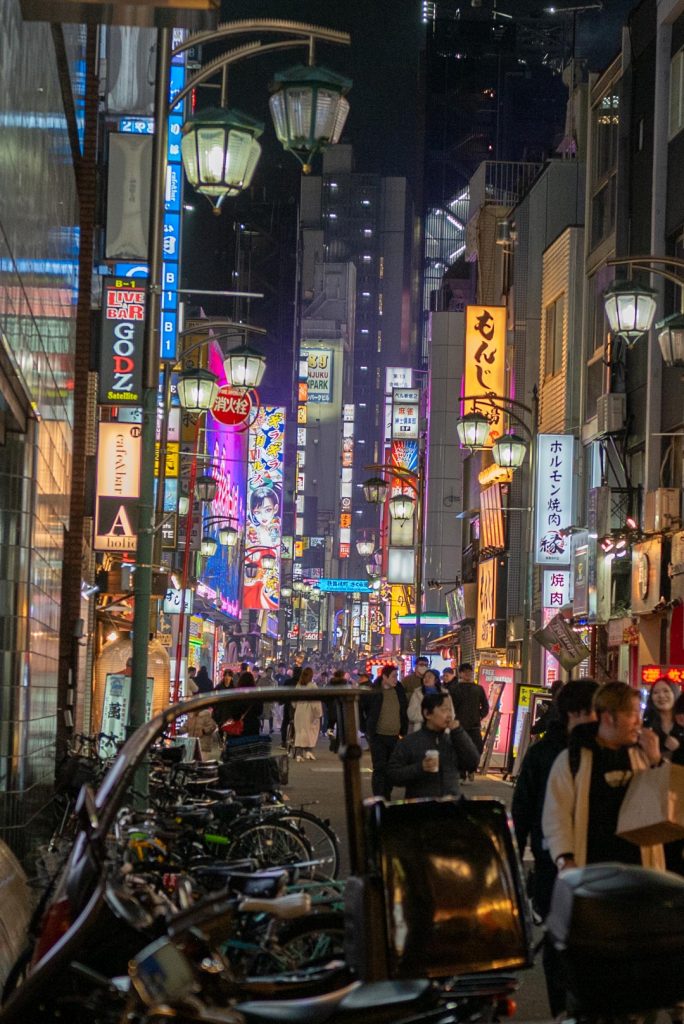
A bit of confusion occurred once when I was in Krispy Kreme donut shop getting a coffee and a couple of donuts, with them not understanding that I only wanted a single coffee and two donuts. I ended up with them trying to give me two more free donuts and I also paid for a second coffee. It’s my fault, I don’t blame the people working there, as I didn’t know the correct Japanese language to engage with them properly. As it happens I just drank one cup of coffee and tipped the other into the waste as it wasn’t very nice.
Silence is Golden
Japanese people are polite in general, there’s no lie in this. In a lift, on a train, nobody makes any unnecessary noise. Whether it’s on the metro, bullet train, elevators or lifts everyone stays quiet. There are signs on the trains and in lifts that ask people not to make a nuisance of themselves by having headphones turned up too loud, or by chatting amongst themselves. It was so quiet on a couple of occasions that I pulled out my phone and used the voice memo app to record the sound of a full carriage on the JR Yamanote line. All that can be heard is the announcements over the speakers, the musical jingles and the bird song, as well as the noise of the train rolling along the rails.
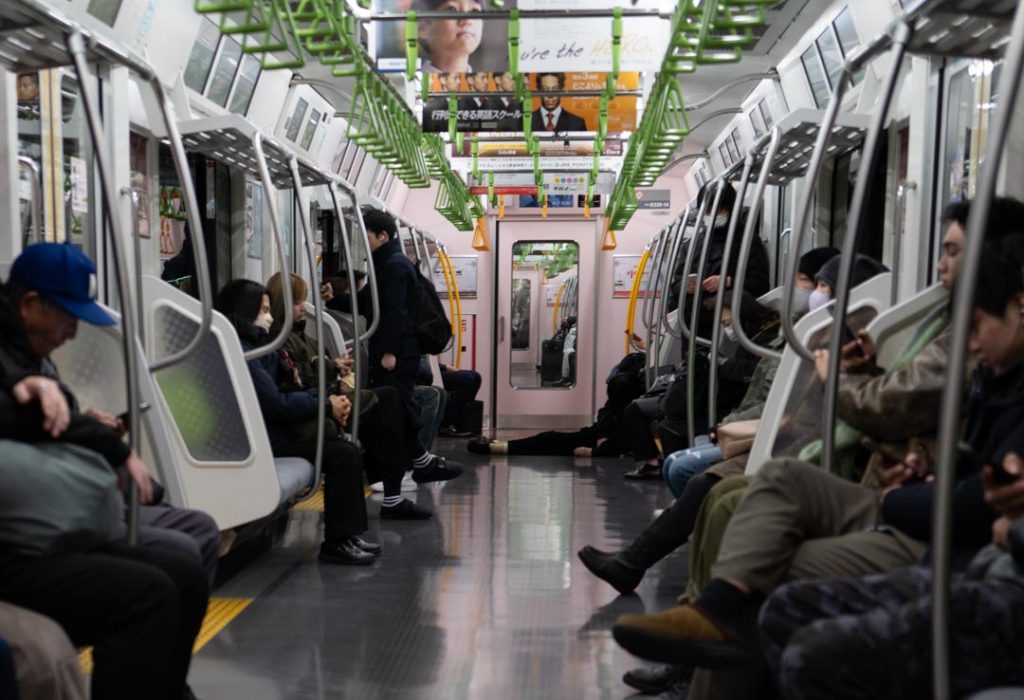
I quite like it actually, just having the peace to think about stuff without overhearing a conversation and getting annoyed by hearing some tinny bass from someone’s headphones. It’s very refreshing.
Swan-like Grace
Over the course of the week I noticed many things about the people around the areas I visited, and admittedly I didn’t go to many places. The roadworks around construction sites had an abundance of workers in full high vis, often with flashing lights all over them, directing pedestrians to the correct path and blocking walkways when lorries were backing up into the sites. Nothing weird here you might think, but whereas in the UK you might get a sign or two and perhaps a construction worker controlling the lights or standing over a hole in the road, in Tokyo it was a case of a worker every five yards pointing the way. There simply seemed to be too many people for the job.
The same was true of the police also, there wasn’t a pair of police walking the beat, when there was an occasion for the police to be present, such as the preparation for the procession outside Imperial Palace, or even around the Russian Embassy near the Tokyo Tower, the Shibuya Scramble was also another location with seemingly endless amounts of police officers on duty.
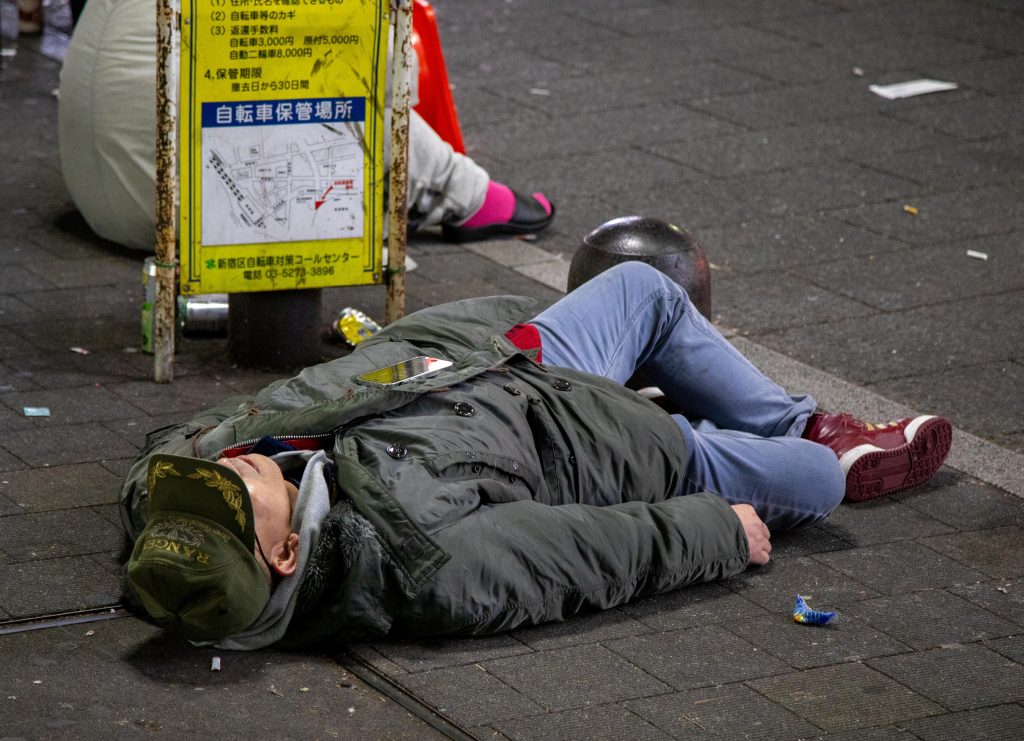
Workers from the offices around the city, all dressed in their suits carrying briefcases were also to be found wandering home or somewhere else at 3am. These people are often called “salarymen” or white collar workers. Many believe they shouldn’t leave their desks or place of work until their boss has left for the day and some spend far too many hours in a day at work. Often, many of them finish too late to catch a train home so sleep on the floor in the stations or even in the streets. Whether they wake up and catch the first train back home for a wash and change before going back to work or not I don’t know. Maybe some of them go straight back into the office. Many of these men, and they’re mostly men for some reason, are seen drinking ’til the early hours as a self celebration for finishing their day.
Even the entertainment district of Kabukicho where my hotel was, are working all through the night and seemingly all finish at around 5am to head home. There are thousands of people going through Shinjuku station at 5am in the morning, none of whom look to be going to work. Some can barely stand let alone talk and work. Young people of all shapes, sizes and sexes are headed home after their shifts in bars, restaurants, show lounges, hostess and host bars, maid cafes, arcades, karaoke joints, and all manner of other more adult places.
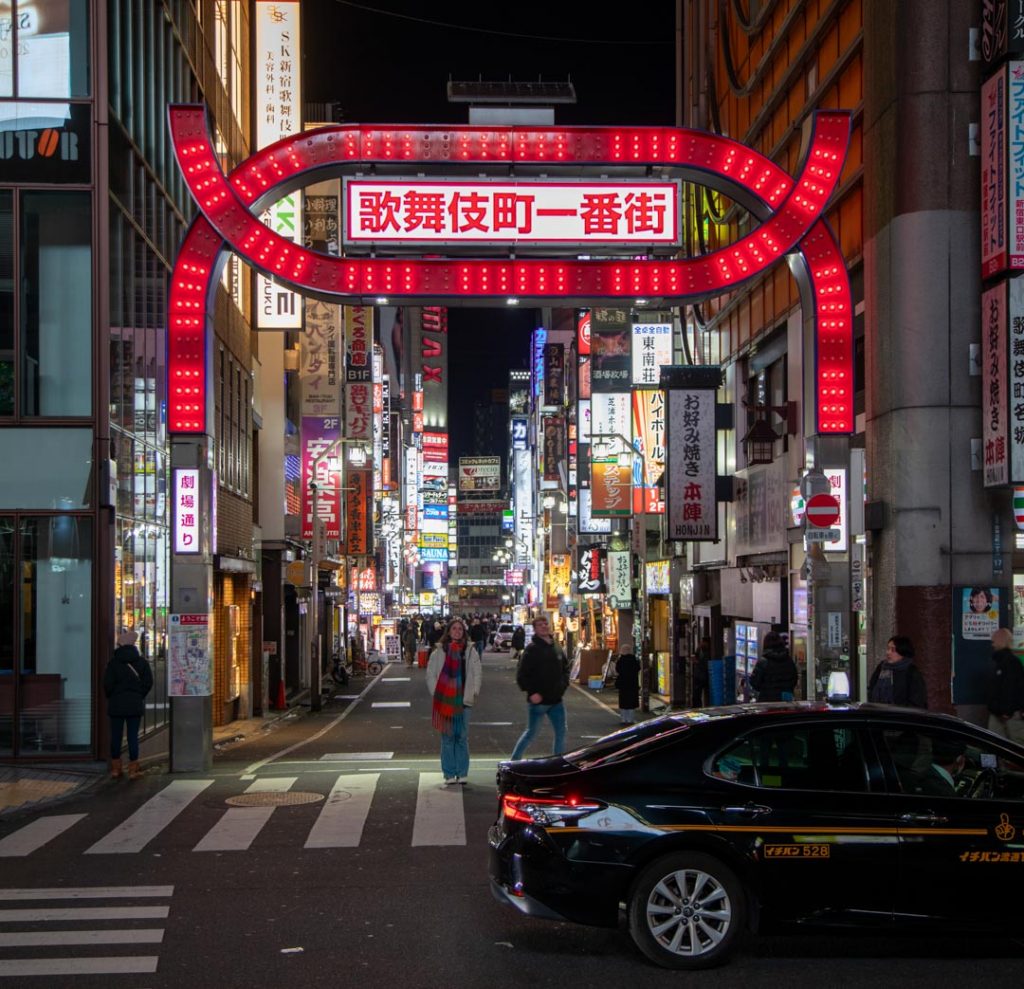
When people ask about the efficiency of the Japanese people, and high volume manufacturing strategies often cite Japanese examples as best practice in engineering, it’s generally considered that they get the job done with commitment and efficiency. My perception though leads me to see it as a big show of efficiency like a swan swimming on a river. The nation travels gracefully across the world but I feel an undercurrent of the swans legs going hell for leather beneath the surface in the way that the workers are treated or choose to behave. It feels like some people work 20 hour shifts, six days a week and barely have a life outside of work to keep up the pretense of a highly ordered society. I’m sure this is likely not the case but this is how it felt to me.
The number of people providing service to each other is mind blowing but is probably a requirement of doing business. I guess if businesses had fewer employees and were slow with service they’d be thought of in a bad light thus causing people distress about being uncomfortable and then not getting repeat business. It goes to politeness too, which appears to be a big thing in Japan. The number of times I saw groups of people saying farewell to colleagues or friends after a work dinner or business meeting when they spent a long time bowing and wishing each other good night etc. It must be frustrating and it seems like they want to be the last to bow. When in shops and other places I always tried to remember to bow politely but I’m sure that I came across like a lumbering bison of a gaijin.
The Transport
I mentioned politeness and silence earlier, nowhere is this more evident than the transport networks. Taxis open the back near-side door electrically to allow you to get in, and also close the door behind you meaning that you never have to touch the door handle. It’s often seen as rude if you touch the door yourself, so I watched for this as I saw people getting in and out of cabs.
The local trains and metro are super clean and tidy, with modern facilities and excellent lighting, signage and train carriages. When I entered Hamamatsucho for the first time off the monorail I heard a bird tweeting as I made my way up the stairs to the exit. I noticed it but thought a bird was stuck in the ceiling cavity. In the UK we often have pigeons and little songbirds in railway and tube stations so I wasn’t surprised. Only I kept hearing it throughout the day in other stations, so I had a look online and found out that the bird tweets are a clever way of assisting visually impaired passengers finding their way through the stations. They help guide people to the escalators or stairs on the way out to the exits.
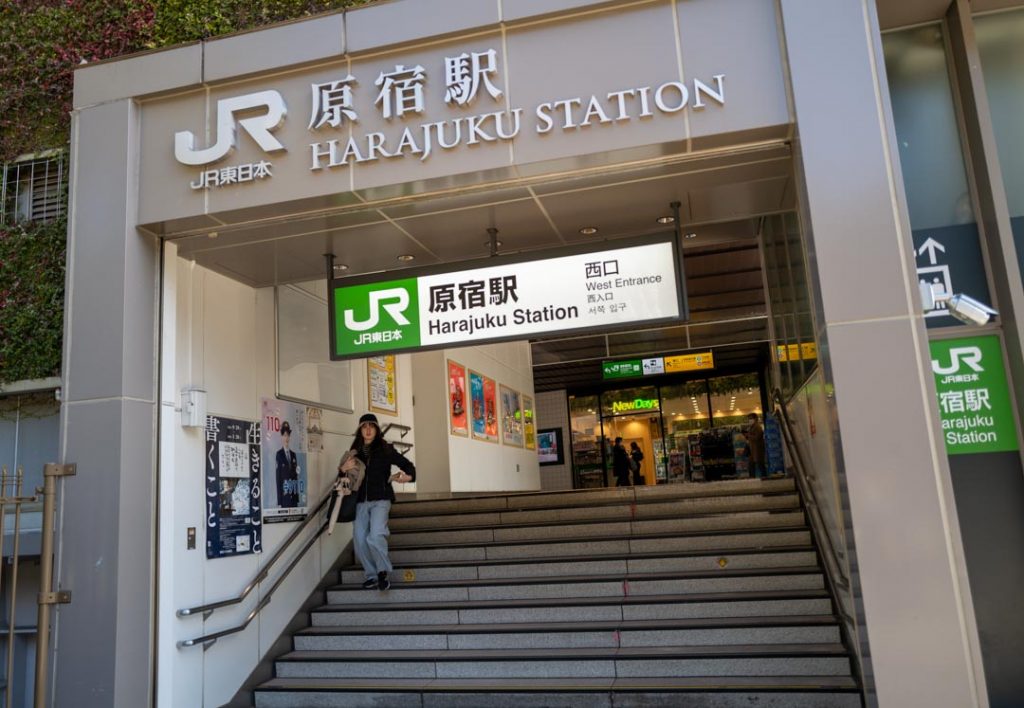
There are Jingles too, like short tunes that play when a train approaches a station, when the doors open and when the train is about to leave. These jingles also help people to know where they are, what line they’re on, such as Hibiya, Ginza, Yamanote or Tozai (like Central, Circle or Jubilee Lines on London Underground). They’re also audio cues to get onto the train and their use prevents people from sprinting to the closing doors of a carriage and ending up having an accident. It also helps that the trains are regular, punctual, clean and tidy.
The staff on the platforms are numerous too, several members of staff stand on the platform at the front centre and rear of the train, and communicate with the guard and driver of the train to ensure that there are no accidents or other issues. It’s like a well rehearsed pantomime. The train begins moving and the person furthest away points to say it’s clear up until the middle person who then points to the nearest to the guard.
This attitude to duty was the same on the Shinkansen too. These Bullet Trains are driven by a single person with a ticket inspector or guard who walks up and down the length of the train. The guard walks into a carriage and bows, then gets to the other end, spins around and bows to the carriage before they leave, repeating the same again in the next carriage. Again, it’s super polite but one can’t wonder how more efficient they could be if they didn’t have to bow all the time.
At Nagoya when I changed trains on the way to Hiroshima I also witnessed a change of drivers. The driver who’d taken us this far dismounted the cabin of the extraordinarily long nosed train and stood opposite the replacement driver. He had a clipboard with a sliding rule on it to go to each checklist item and sign them off before the handover was complete. With the checks completed and both parties happy, a bow and salute to each other saw the ceremony concluded.
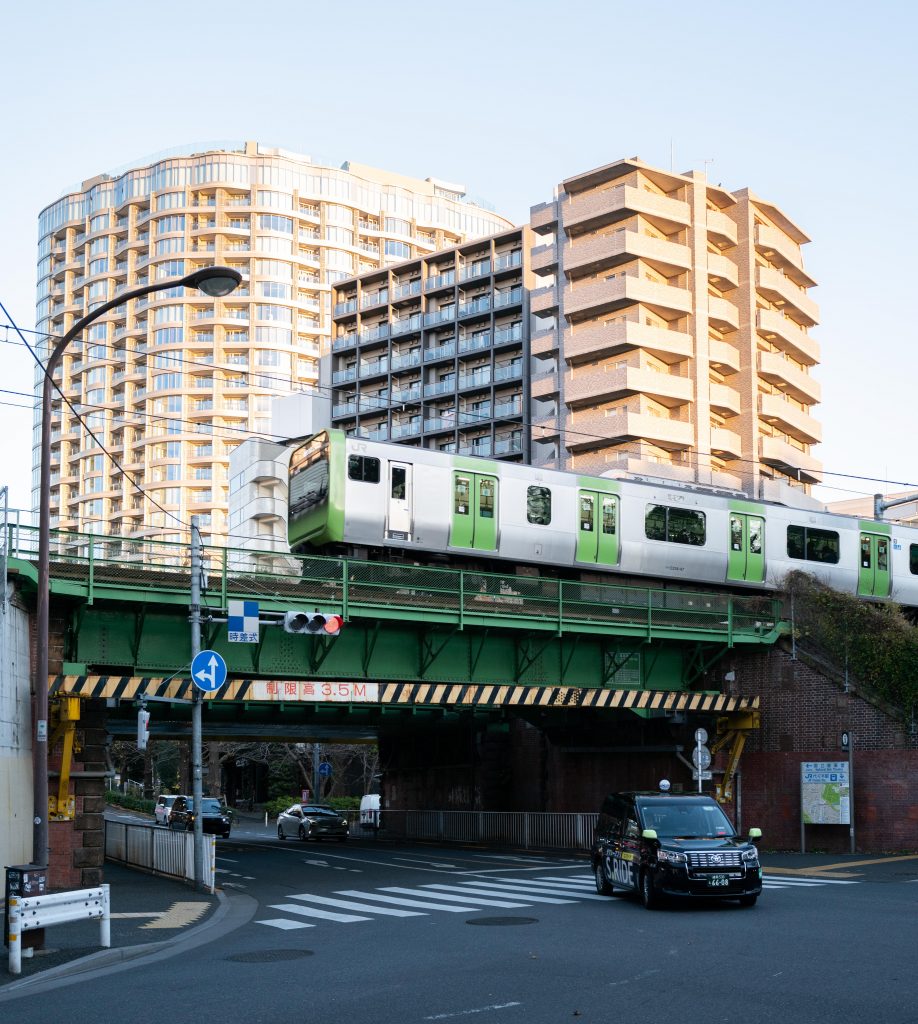
As I was taking photos of a Shinkansen train I noticed that the driver was a female and as I raised my camera to capture the elegant lines of the train I could see her head through the windshield, then she gave me a little wave. Eager to help a tourist get a little bit more joy from the experience of bein gin the country, I found it a touching gesture that she didn’t need to do. The drivers are all super smartly attired in their uniforms reminiscent of an airline pilots garb. I can’t find any recent figures but in the early 2010s the average salary for a Shinkansen driver was around 80k USD per year which isn’t a bad number at all, but I don’t know if I could deal with the stress.
Many people have asked me about the bullet train since I returned home, and whilst I know that it is amazing that they all run on time, to the minute, and they run at such high speeds, they’re just trains. That sounds ungrateful but I don’t mean it that way. The trains I rode on to Hiroshima are said by Japan Rail (JR) to travel at speeds up to 185mph. This matches the Eurostar train in the south of England, which runs for a short period compared to the journeys across Japan. The tickets for Shinkansen would have been around £140 one way to Hiroshima so I got a JR Pass which allows me to ride on most Shinkansen lines without further costs, as well as the JR East lines in and around Tokyo. To get a JR Pass though, you have to order it before you get to Japan, you’ll get sent a Voucher in the mail and this is what you take to the ticket office when you arrive in Japan. This is to prevent Japanese locals from taking advantage of this scheme designed for tourists and visitors.
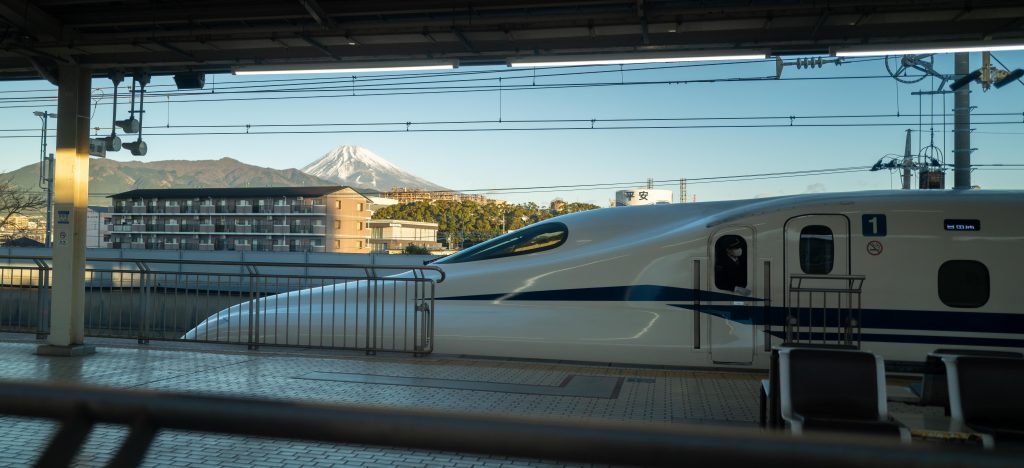
The speed is amazing but when you board the train and sit down, the train sets off like any other train I’ve been on. There is no instant G Force like you’re in a cockpit of an F18 with Maverick, just a smooth ramp up of speed before a gentle slowing down to enter the the stations. The inside of the trains is interesting also, if you like this sort of thing. The trains never turn around, they go up the line one way and then just drive the other way to come back. Seat E on every row is a window seat and as you leave Tokyo to go to Nagoya, Mount Fuji can be seen from the E seat, providing a spectacular view of this impressive active volcano. Once the train reaches the end of the line, it simply switches gear and drives the opposite way back down the line. The clever thing though is that the seats are all made to have a rotate function on them so rather than the train spinning around, the sits turn on their pivots and face the opposite way. Hence Seat E is still next to the window with the view out over Mount Fuji on the return trip.
The local and metro trains are just as punctual and clean as the Shinkansen. When waiting for the train you are supposed to stand behind the yellow line and if they’re there a spot. Then the next person behind you stands on the next spot and if there are too many people, they stand on the spots next to you which are for the next train afterwards. It’s all very organised and polite, as opposed to the London Underground where people just pile around the entrances to the carriages and then barge their way on to the trains. In Japan there was never any jostling or pushing. The train did get busy at a couple of points when. I caught a rush hour, but there was silence and no issues at all.
The lines they have are equivalent to the lines on the London Underground, but on the Metro they have station names and numbers, so Shinjuku would also be known as F13, S02, and M09, the F is for Fukutoshin, the S for Shinjuku, and the M for Marunouchi lines. the map is similar to TFL maps and is well organised making it relatively easy to get to anywhere in the city you might care to go. There is a loop line too called the JR Yamanote line which goes all around the city in an hour. So you should never be more than thirty minutes away from anywhere. The stations have signage in both Japanese and International English which is very helpful and although I tried to pick up on a few words in the script language I couldn’t manage it. The platform numbers and next stations are documented on pillars and gates along the platforms to ensure you get on the correct train, but hey if you get on the wrong one, you just go to the next station and return on another train. It’s no drama at all.
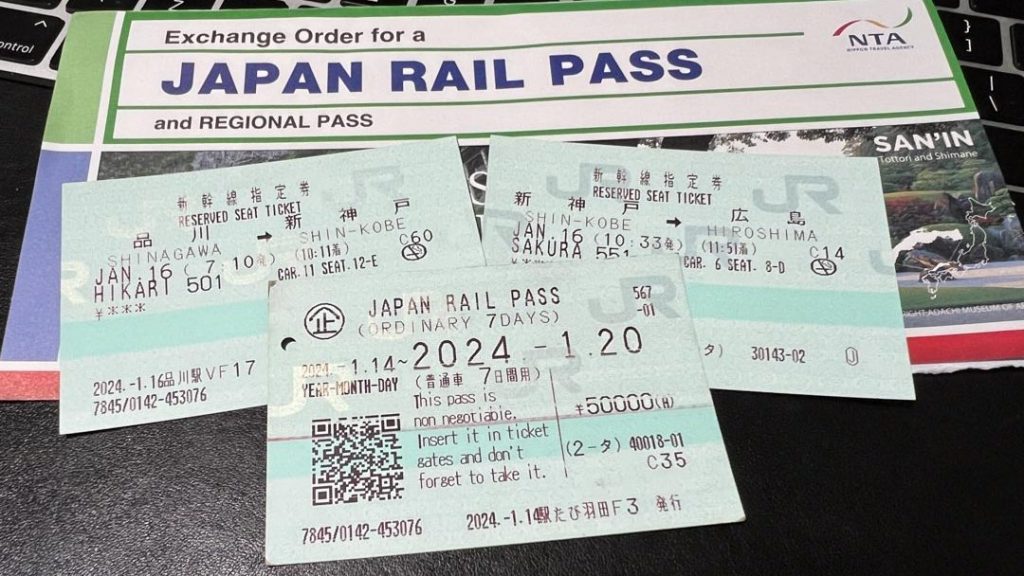
There are a lot of walkways between stations in some cases, a big one was by Toranomon where the next station to get onto the train was 500 metres away down a long corridor. The long and wide, brightly lit corridor was like something from 2001 A Space Odyssey, honestly. There was no graffiti, no chewing gum all over the place, no litter and no people lying around making a nuisance of themselves. I found myself walking this route a few times and it always seemed to get longer every time.
Taxis and other vehicles were very interesting to me also, as the Tokyo Taxis have a particular look to them with the little light on the top and the text on the decals identifying it as a Japanese vehicle. Some of the black taxis looked really nice with the lights reflecting on them and I wish it had rained some so I could get even more reflections in a picture. It was amazing too how many little cuboid vehicles there were on the roads too, barely any huge Mercedes or BMWs, I didn’t see any Barbarian/Navara style utility vehicles or Land Rovers over there. There was the odd Merc G Wagon in Omotesando Hills or an occasional Lamborghini but very few of these supercars. I guess there must be some tight emissions controls in the city of Tokyo.
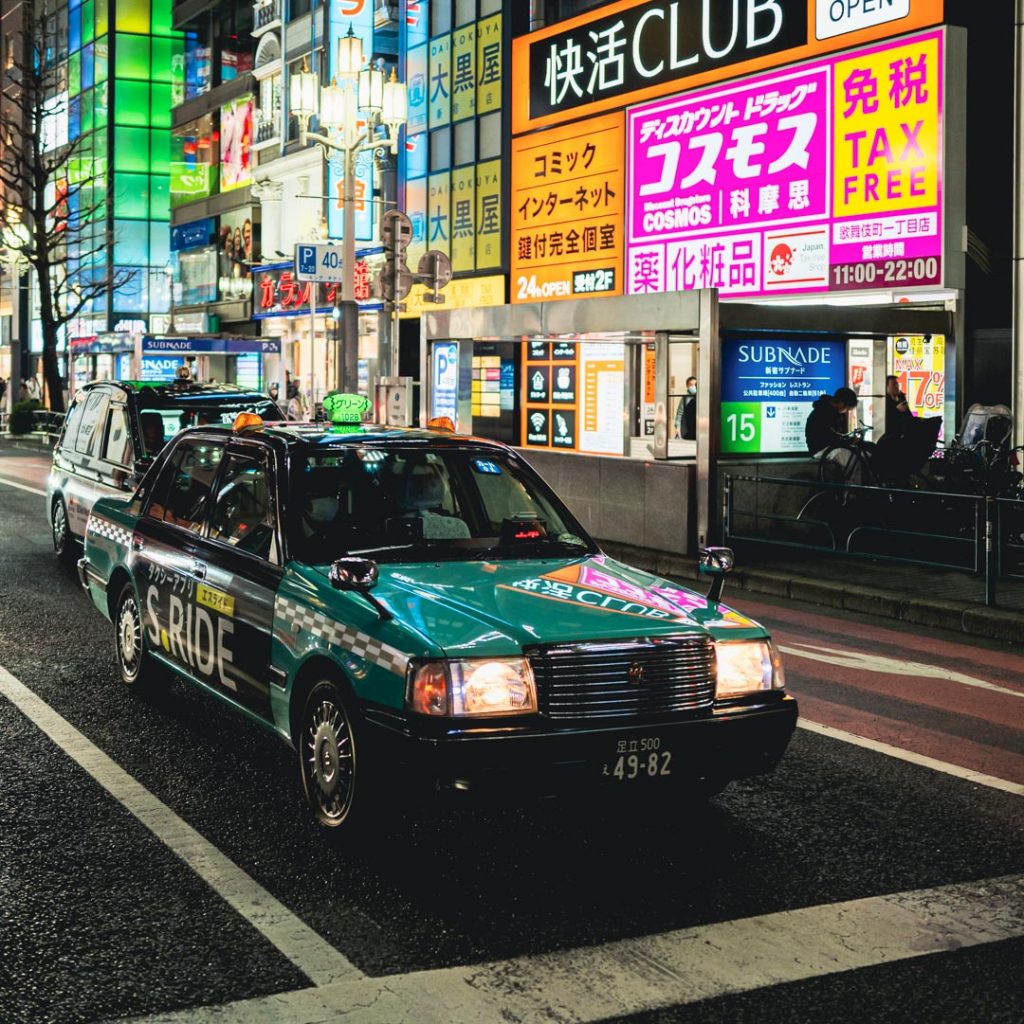
I also noticed a couple of times that bin lorries (Trash Trucks) and other delivery lorries, when they were parked had wedges or chocks under the wheels. Whether this is a rule of the road there or not I don’t know but I did see the drivers having to remove them after finishing deliveries.
There were a few bikes around the cities too, which was good to see, many of them electric with even a couple of Super 73s seen around the Kabukicho district. There were also a few electrically powered scooters milling around but not as many as in London.
The other transport that I saw was the Mario Kart style racers going around the city’s roads with tourists snaking behind the guide as they made their way past Tokyo Tower and over Shibuya Scramble etc. It looked good fun but to do this you need an international driving permit, which is only a couple of quid at a post office counter in the UK. Once you have the IDP you can take part in this fun activity, they even dress you up in Mario Kart costumes too.
The Hotel & Area
I selected the Hotel Gracery long before I made the journey, using Expedia to book the hotel and flights together. The cost of the hotel and flights was £1800 in total, not too bad for the whole thing really, I’d been saving up for it for a while and preparing myself for the adventure. It”s a long way away and the hotel was clean, tidy and well looked after.
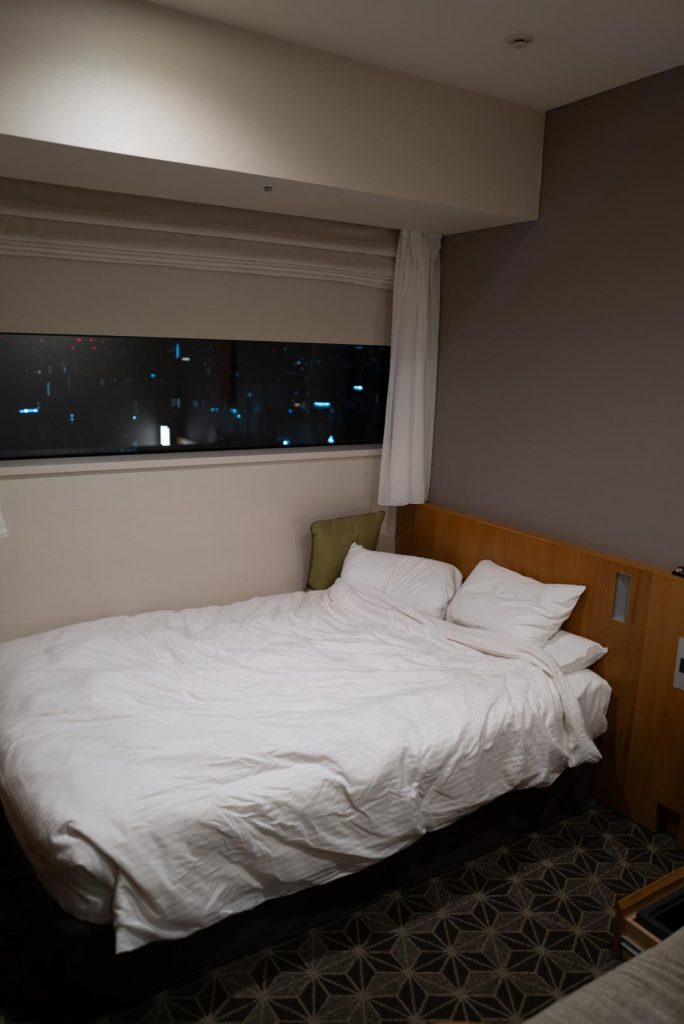
After checking in a bit early, due to being knackered from the flight and not having any luggage, I made my way up to room 2115, this is on the 21st floor, there are 30 storeys to the hotel and outside the window on the patio at the 8th floor is a huge Godzilla head and arm. The area was closed off but in the summer I think it’s a deck you can go out onto with a cocktail or two.
My first night in the hotel, once I eventually tried to get to sleep, was trying to sleep with the brightest of lights outside the window invading past the dark blinds. Before I went to sleep I did take. a few photos of the view that was similar to that in Ridley Scott’s Bladerunner movie.
I didn’t use the restaurant as you’ll read about further in the food and drink section below, but the bar seemed to close awfully early in the evening too. A couple of times I went back to the hotel to change cameras and it was closed at 9pm. The staff were excellent on the check in desk and I never saw a room cleaner at all.
The room I had was a Double Standard and it was small but adequate, if it had been me and my wife it would have been ok, but I wouldn’t have wanted to have a kid in the room too. For me as a solo traveler it was ideal. The toilet had a warmed up seat, and a spray and bidet that cleansed after you’d had a visit. The bath was long and deep enough that I could have a soak after walking 18 miles in a day. The shower wasn’t over the bath but onto the wet room floor which was odd but hey, it worked. There were free toiletries in soap, shampoo and conditioner, toothpaste, and toothbrushes, dressing gowns, slippers and hair nets. There were tea and coffee making facilities hidden in the cupboard but it’s rare that I use these in any hotel as there are some people who use them for other purposes.
The TV in the room had BBC World on it and I used this channel to check up on the weather and any news that might be coming my way. Don’t forget that a couple of weeks before I was due to travel out there was a huge earthquake on the north of the island, and also an airliner crashed into a coastguard plane on the runway at Haneda airport. I was waiting for another disaster to complete the three but it never came our way. I did feel for the people who perished in both of the aforementioned disasters though, what a horrible couple of ways of being killed.
Under the hotel there was a TOHO Cinema and Entertainment complex as well as some take out restaurants, 7-Eleven and even a KFC. It wasn’t difficult to buy anything you needed as there were loads of shops around.
The area around the hotel is known as Shinjuku and Kabukicho and is known for being and entertainment district with some citing it as a red-light area too. There were plenty of clubs, bars, Karaoke places, arcades and hotels, host and hostess clubs and even love hotels around the area. Trying to get tourists and locals alike into these places were touts, either young men or women trying to persuade people to use their bar for a set fee that seems like a good deal, but research before leaving meant that I trusted none of these people and kept away from them. There were even some guys there who start a conversation in fluent English with you and then don’t give up until they’ve tricked you into going to a secret bar where you have to buy drinks for the girls in there at extortionate costs no doubt. No thanks. As I walked past these people I said “no thanks, hope you have a great evening” and carried on, trying to be assertive and not showing a weakness. It served me well and I only had one guy who continued for another sentence about “girls and chicken” before he got the message I wasn’t stopping. The place is lit up by signs everywhere and skyscrapers dominate the skyline all around, with the newest one next to my hotel called Kabukicho Tower which is massive and was only completed in 2023.
From the road leading up the hotel which is called Godzilla Road you can see the massive Kaiju peeking out and I believe on the hour it bellows smoke and light from his mouth although I never saw this as I was too busy poking my camera in another area of the city.
I know I mentioned the area being full of touts for nefarious bars etc, but I must admit to never feeling threatened at all. Even when I was wandering around the city at 4 or 5 am with my cameras I never once felt like I needed to prepare to deal with someone coming to attack me. In London I’d rarely go into back streets after dark unless it was well lit, and in New York back in 2019 I felt threatened walking back from the Empire State building at 1am with my family.
Maybe it’s because I’m a big unit that i didn’t feel worried about my personal safety or just because the crime statistics are so low in the city. There was a single place where I witnessed a collection of drunks and that was in the square outside the Kabukicho tower and here were youths gathering to drink and make noise, as well as salarymen and people sleeping on the paths and walls around the area as they couldn’t make it home. In these areas too was where I saw the most litter, cans and wrappers were discarded on the ground by these revelers and people experiencing homelessness. It didn’t stay messy for long though, trash cleaners were on it early in the morning to prepare the city for a big new day.
Photography
The whole purpose of the journey to Japan was to take photographs that fitted in with my expectations of the country and the city areas. Think of Bladerunner and CyberPunk inspired artworks, movies, games and books. The neon lights and reflections of them in the rain soaked streets with the Japanese folk carrying transparent umbrellas were the image that I had in my funny little brain.
To capture the images I wanted to I took a selection of cameras.
- Canon A1 35mm Film SLR with. a 28mm f/2.8 lens.
- Bronica ETRS 6×45 120 Film Camera with a 75mm f/2.8 lens
- Canon 5D MkIV Digital with 16-35mm f/2.8 and 24-105mm f/4 lenses
- Leica Q2 Mirrorless Digital Full frame and 28mm f/1.7 fixed lens.
I had a tripod in my case, the remote shutter release cables, a selection of films in colour and black and white as well as a big collection of batteries and memory cards.
I had also packed a laptop and spare 4TB USB hard disk so I could back up the photos when I returned to the hotel room. Unfortunately, when my bag was left in Paris for an extra day, my laptop, ETRS camera and all of my chargers were also in there. Not that it mattered too much really, as I was out with the Leica on the first night and morning I was there.
There was not enough rain, in fact there was no rain at all. I am probably the only person that goes away and hopes for rainy weather. One of my work colleagues had flown out to Tokyo the day after me and said that he hoped I got some rain once he’d left for home again.
I went around everywhere with my digital cameras and took out the film cameras only when I took my backpack with me. As a result I took over 5000 photos on digital cameras and around 150 on film. The main places for film photos were around Hiroshima and also in the night time at the district of Shinjuku and Kabukicho.
Despite the many lights on buildings and around the city I felt that trying to use an 800 speed film to do do some street photography at night might have resulted in very poor outcomes. So I found myself using the Canon 5D at night most of the time, the ISO at higher ratings appears to perform better than the little Leica Q2 so when I knew I was going somewhere dark or at night time I took the 5D. A prime example of this selection process was the visit to the teamLab Planets exhibition, when i knew for sure that it would likely be very dark with lights in the artworks. The leica was left in the backpack in the locker room under lock and key and I travelled around with the big lump of a camera. The 16-35mm was a good tool at night owing to the f/2.8 aperture maximum and I did capture some nice images.
The film cameras came into their own in the Shinjuku Skyscraper district and I was carrying around only the ETRS on a tripod the one evening to use up some rolls of Portra 800 to see how they came out. The photos came out ok as I have since scanned the film on the scanners at the university.
In this district stand the Tokyo Metropolitan Government Buildings and one night at around 1:30am I was stood making photos underneath the large towers and a security guard made his way over to me. Without speaking a word of each others languages I knew what he wanted me to do, so I did exactly that and left the location. After this encounter I moved to the area under the bridge and found a lot of taxi drivers chilling on the side of the road as well as a few rickety built shelters that people experiencing homelessness were sleeping in. I didn’t feel unsafe at all but I did see a few confused faces looking at me and wondering what the hell was I taking photos of steps for.
The inspirations behind going to Tokyo were two books by Liam Wong and Masataka Nakano amongst many others who did street photography and urban architecture and landscape photos. I found that most people didn’t really pay attention to me for having a camera in front of my face and snapping away. Some of the locals were curious by my use of a film camera and a few others were looking to see what cameras I was using to capture scenes of their daily lives.
I never once had an issue with anyone objecting to me capturing their likeness on sensor and there were a few positive encounters when people engaged with the camera and the process of recording a scene. I was quiet and discreet when on the metro as I couldn’t afford to make a lot of noise and distraction on such a quiet place.
One place I wanted to go and take photos was the Shinjuku-ku area near the GAP flagship store and Lumine Est shopping centre. I did this location on my first day in country and it was a nod to Masataka Nakano who produced a book called Tokyo Nobody and one of the photos of this area I showed to the group in a seminar and it featured zero people in the shot. I wanted to visit the area more than ten years after his photo and see if I could capture a picture with the usual amount of people in it. It was already a bit late and the sun was going down but I did find the place, even if it has changed a lot from the days of Tokyo Nobody. The escalators have roofs over them today, and there is a huge development (The JR Shinjuku Miraina Tower) to the left of the picture . The tree at the foot of the escalators has obviously matured somewhat also.


Common subjects of my photos taken whilst in Tokyo and Hiroshima are Taxis, Trains, People, Buildings, Manhole Covers, and Streets. I did take photos of vending machines, shops, cars, houses, electrical cabling in the street, museums, exhibitions, and all manner of other images.
There was never a time when I felt like I had nothing to photograph. Whilst back in the hotel at night I would download the days images to the external 4TB drive through my laptop and also using the wifi in the hotel I would copy as much as possible to my 365 Onedrive files.
Once home I found I had over 5000 photos from digitals and at least 10 films to get sent off. Once sent off to AG Photolab in Birmingham I got them back and scanned them in at the University using their great scanners. Some of the images came out well, with some over or under exposed but I guess it will be recoverable in the darkroom.
Weather
No doubt about the weather, I was gutted. It was lovely and warm for many days and a bit nippy on others but always a bit chilly in the wee small hours. Not a single drop of rain though. All I wanted was for a good drop of rain so I could go out and get some good Liam Wong style images with the reflections of the lights in the wet tarmac and footpaths.
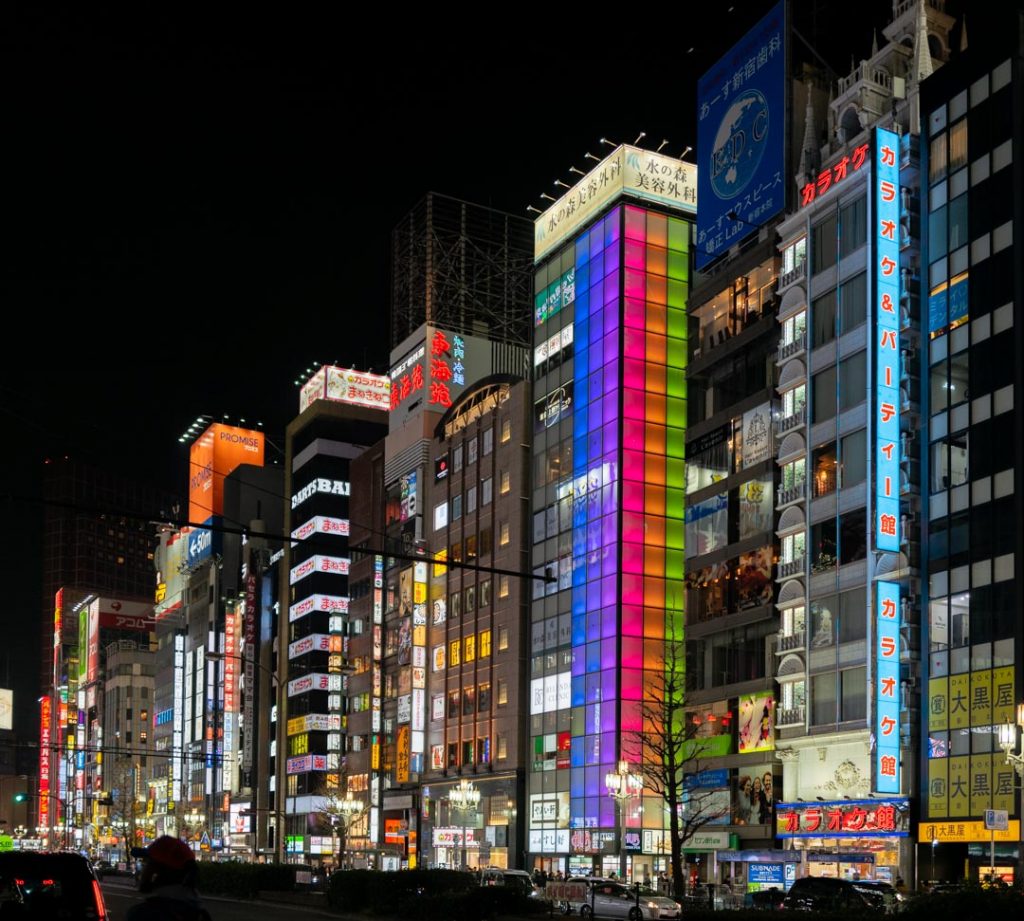
Some days I was walking around in a t-shirt and others in my big coat. It was tricky to get the balance right though, if it was cold outside, on the metro and in the stations was boiling. I was having to take my jacket off or I started to properly sweat. Apparently, according to many videos I watched on youtube before going out to Japan there is an issue if you don’t use deodorant, but there are also few shops that sell the same style deodorants as we have in the UK. For the first day I had no baggage and my Dove deodorant was in the case along with my Bronica ETRS and I couldn’t see any in the 7 Eleven.
When I got there without my luggage I went to Alpen Tokyo and purchased an Adidas jacket that was warm enough to walk around in, but not as warm as my jacket to make me sweat. the issue with this is I bought an XXL size in the shop but it is obviously not the same as XXL back in the UK as it was a bit tight around my sizeable midriff. It kept me warm enough though so that I could continue my meanderings through the city without feeling chilly.
Food and Drink
If you know me, you’ll already know that I am not a foody, categorically and unequivocally not a foodie. I eat when I feel a need to, not prescribing to usual mealtimes, never having breakfast, and not eating anything adventurous at all. Even in the UK I do not enjoy all of the processes that go into eating to stay alive. I can’t be bothered with planning meals, doing the shopping, preparing, cooking, eating and washing up. It’s tiresome and having to stick to set times really holds me back.
As a result of my nature I was wandering around all day and night in some cases with barely anything to eat at all, and when I did feel like something to eat I’d pop into a convenience store and choose something plain and unexciting to get me through and tide me over until later.

One day I was up at 5am to go to Hiroshima and spent 4.5 hours on the bullet train and a wander around the lovely city and museums etc. It wasn’t until around 4:30pm that I realised I hadn’t had a drink or anything to eat at all. I’d grab a bottle of Coke from a shop or a vending machine on the street, actually good value too at 170yen per bottle which is far cheaper than back home.
Restaurants do not do anything for me at all, the faff and show of the chefs and the foods available are a delay to me doing what I really want to do so I just take an easy path, find something I know I’ll eat and then get sorted and move on. Whilst I was in Japan I visited MCDonalds twice , KFC once , Family Mart many times, Mr Donut once, 7Eleven many times, Lawson Station once and Vending Machines about 5 times. From stores I’d eat crisps, chocolates and other conveniently packed ready to eat items such as fruit. I had a couple of donuts too and I found these places great to sit in the window and weigh up what was happening outside. I know that to many of you this sounds like sacrilege and a waste of a trip to a foreign country, why go and not try their food? However, I’m stuck in my ways and with all of the hassle around eating I find it far more convenient to pick up something quick and easy that I know I can eat without retching, I’m not adventurous or even interested. I suppose that I’m into food and tasting as much as other people who might be into Batman movies, or photography or even computers.
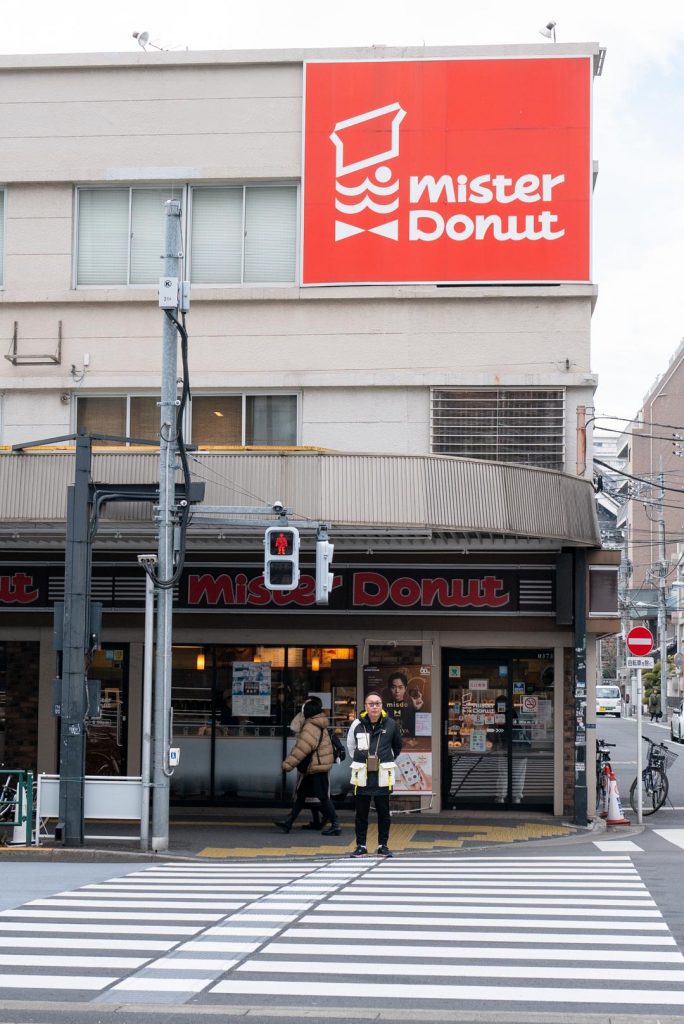
I’d buy orange juice for the morning If I remembered and keep it in the fridge ready for when I awoke. Other drinks were plentiful with beer, spirits and a full complement of specialist Japanese drinks like Sake. I do not drink alcohol though, not for any reason other than I just don’t want to. Some of these feelings might go back to my Dad being an alcoholic but I do feel that once I’ve had a drink or two I am restricted in what I can do and where I can go. Bar’s weren’t anything I was interested in really but one night I stopped in a bar by the Hotel Gracery and sat there with a Guinness Zero whilst watching the world go by from my seat out front. I wouldn’t want to tie myself down to getting hammered in a bar either, I’ve heard a few stories of people being taken advantage of when drunk and losing a lot of money on their credit cards, and whilst I felt comfortable at this one bar, I didn’t feel as secure to go up to a 5F (fifth floor) or -1F (basement) establishment where nobody knew where I was.
There is also no eating or drinking as you’re walking along the street so to have to stop and eat anything just made me feel like I was being held up from getting on with my random ramblings. Food and drink is obviously a huge part of the Japanese culture and I also feel that if I’d gone into a restaurant and asked for a basic chicken and chips that I might have offended someone and that’s one of the last things I want to do anywhere. I do not want to offend people and often have difficulties going to friends and family events because I’d rather not eat anything there, but most people are used to me and weird quirks by now. After all, with all of my good points, and there are a few, or so I’m told, surely this balances out my weirdness around food.
The Attractions
When in Japan I wanted to visit a few different places, such as Tokyo Tower, Tokyo Skytree, Shibuya Scramble, Hiroshima, teamLab Planets and a few museums etc.
I managed to fit a good number of places in on this journey but I will need to revisit Japan to go to a few of the places I didn’t make it to. The Tokyo Tower and Skytree are both great attractions to visit and going up as high as you can to look out over the immense metropolis is definitely an experience. If you’re on a budget though you can easily get great views of the city from the Tokyo Metropolitan Government Buildings, Bunkyo Civic Centre or even the Sunshine 60 in Sunshine City. These latter places give you amazing vistas with Mount Fuji viewable and all of the other large towers you can see in and around Tokyo.
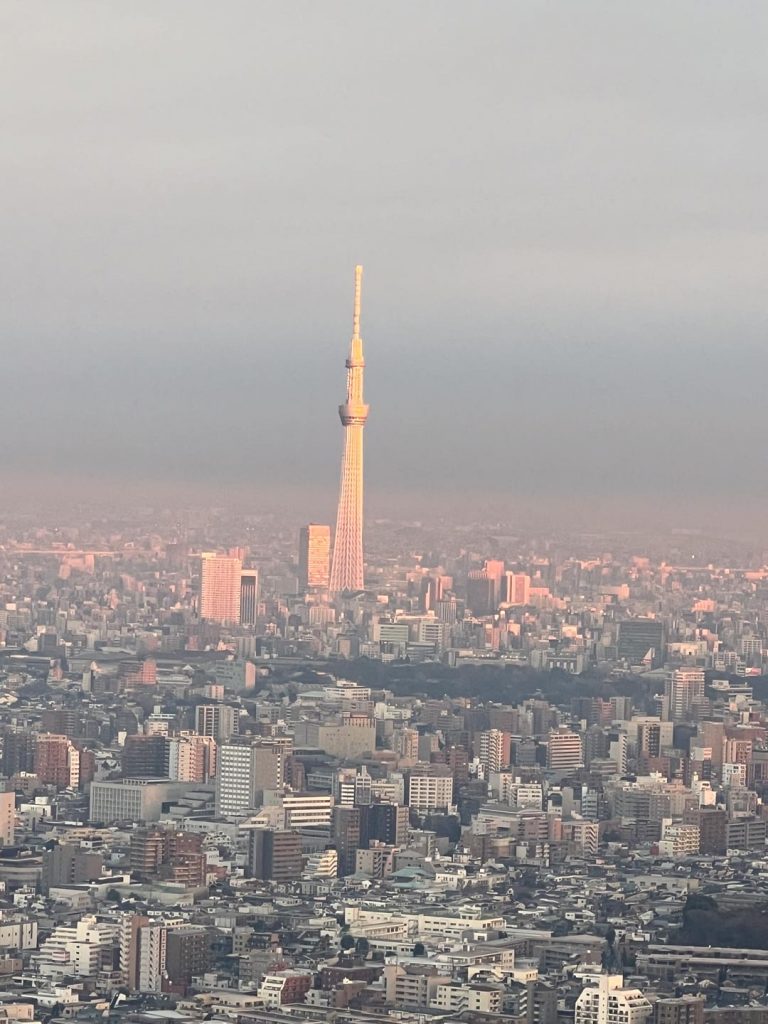
The Meiji Jingu shrine was a peaceful place and nice to wander around but it felt a bit commercial to me, possibly because I have no religious faith. Also the Senso-Ji temple and Shrine were amazing and a sight to behold with wonderful architecture and engaged people but i still felt a little hollow.
Harajuku as a shopping district is cool and Omotesando Heights containing all the brands, but I’m about as comfortable in high end shops as I am in restaurants. Other shopping is available in the city districts and all manner of goods can be found in the huge number of BIC Camera stores, which despite the name sell all sorts of electronics, not just cameras. These shops didn’t feel as futuristic as I can imagine they might have done in the past, probably due to the western world having access to loads of gadgets and tech nowadays.
Shibuya Scramble was interesting to see at ground level and I think there must have been people there for hours just going back and forth over the black and white striped crossing whilst recording little videos and taking selfies. The traffic there was also good to see tearing through the middle of Tokyo, and it was even funnier when the Mario Kart style racer go-karts come whipping through the massive intersection. I never got up high enough to look down on the crossing as I was trying to get into Shibuya Sky but it was booked solid whilst I was there. I have since found out that there are other buildings where you can go up and look out over the famous Scramble but I never found out about this whilst I was there.
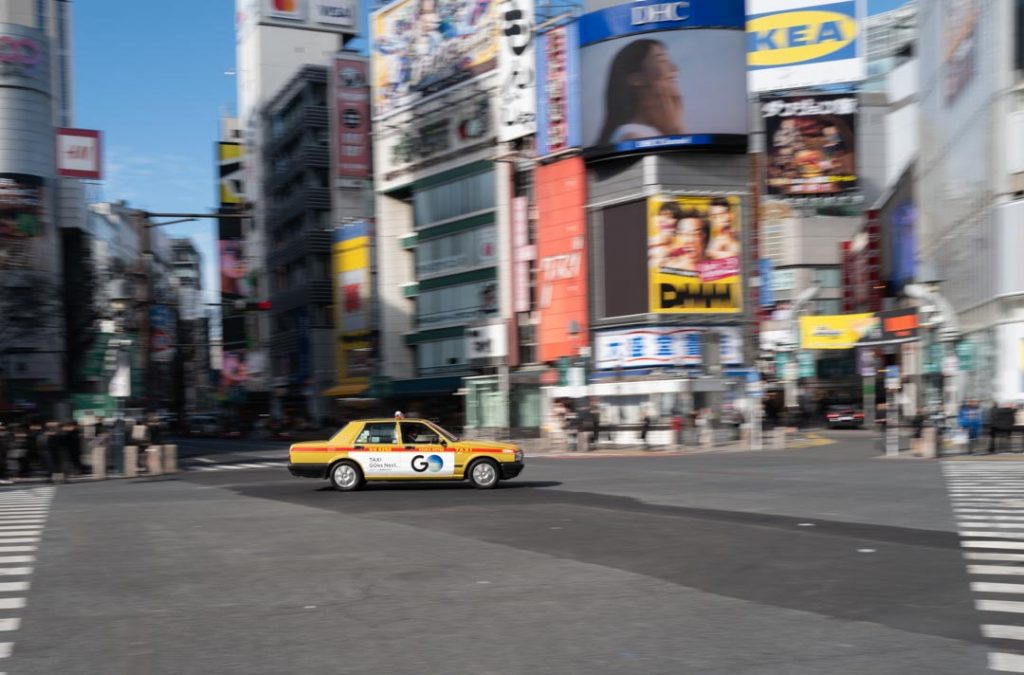
teamLab Planets was amazing too and a fully featured art exhibition featuring several fantastic and mind-boggling works of art. Each room was amazing to go into and experience and the strangeness of having bare feet was also more engaging. There is a new teamLab Borderless which opened three weeks after I left Japan that has some other weird and wonderful art installations inside and maybe if I return I’ll get to see this too.
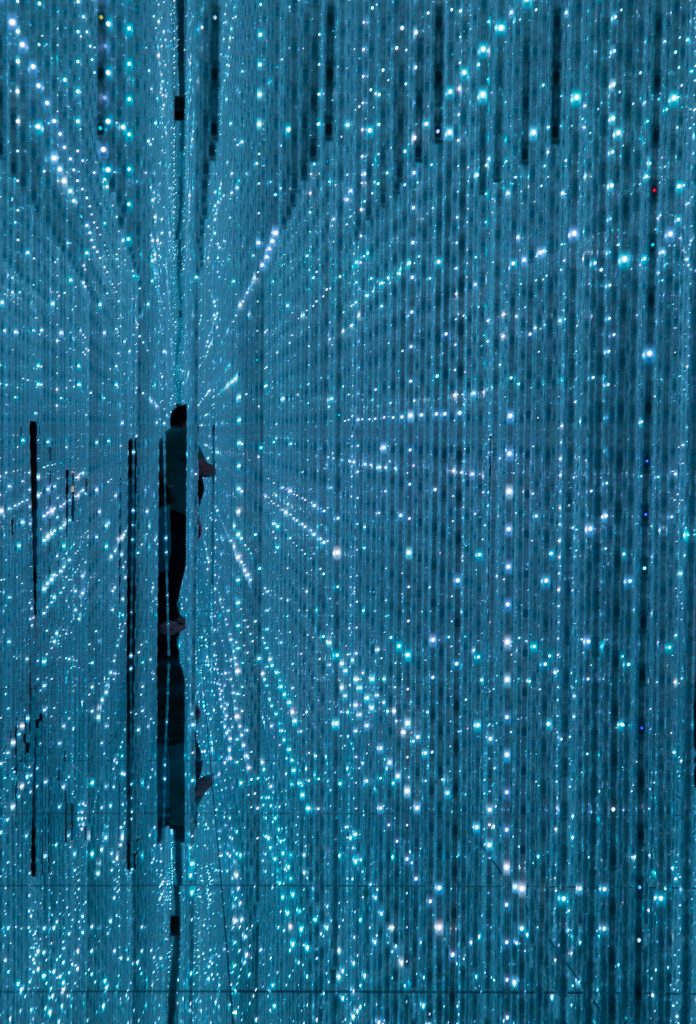
Hiroshima was worth a visit too just to be in the place that is famous in human history and learn the horrors and tragedies of the city on that fateful day in 1945. Let’s hope that nobody ever does that again eh? The questions raised here are odd though, some of it seems to blame America solely for the bomb and almost appears to forget the fact that the war was underway. This is paralleled in many other museums around the world in which the propaganda is almost automatic and seems to rely on people from different places never visiting. The people here were super friendly too and the Peace Memorial Museum and Gardens were beautiful and thought provoking, as is the Atomic Bomb Dome, which weirdly I thought more people would recognise from my photos.
Return?
So after all of the posts and this final post, would I return to Japan? Hell yeah I would. Not for the Cherry Blossom of course but to visit some of the other cities and spend a day or two in these different places, maybe even drive out into the countryside and take some rural photos of the little towns that you fly past on the Shinkansen. The people are really polite, to a fault sometimes, but I think I should probably learn a little more Japanese language so I’m not completely useless at communicating with the locals.
I’d definitely go again, on my own so that I could please myself on the schedule without feeling guilty or annoying people journeying along with me. I find that photographing on my own always allows me to go into a sort of meditative state where I think about nothing except the next footsteps direction. Wandering around like this has seen me find some wonderful little nooks and crannies in all places I do it. Having to apologise for holding up a journey to a restaurant or somewhere else ruins that positive experience for me as I feel as though I am annoyin gpeople and becoming annoyed at simultaneously.
Once I’ve finished going through the photos and deciding which places I want to revisit I’ll definitely update this blog with that info. Thanks for reading this far and if you have any questions reach out to my via the links at the top of the website.
Previous Posts on Japanuary trip.
Day One, Day Two, Day Three, Day Four, Day Five, Day Six, Day Seven
Be First to Comment